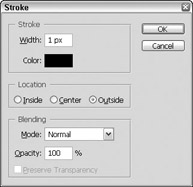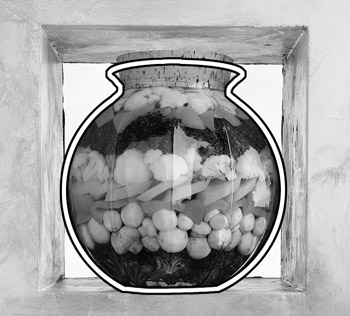Using the Stroke Command
The Stroke command traces borders around a selection. When you choose Edit→Stroke, Photoshop displays the Stroke dialog box, shown in Figure 13-12. Enter the thickness of the border you want into the Width text box. This value is measured in pixels and the range is 1 to 250 pixels.

Figure 13-12: Use the Stroke dialog box to draw a border around a selection.
| Tip | You can enter units other than pixels. For example, if you type 2 inches into the Width text box, Photoshop converts the value to an equivalent number of pixels. |
Creating a border with the Stroke command
You can use the Stroke command to add artistic border effects to images. For example, In Figure 13-13 I traced a 16-pixel wide black border around the jar. Then I swapped the Foreground and Background colors, chose Edit→Stroke again, and entered 8 into the Width text box. The result is a white border inside a black border.
By default, the stroke color is based on the current Foreground color, but you can pick a different color from within the Stroke dialog box itself. Simply click the color swatch, and you’re transported to the Color picker.
Making the border ride the track
The Location options in the Stroke dialog box determine how the border rides the selection outline. The border can cruise around fully inside or fully outside the selection, or it can sit astride (centered on) the selection.
Why might you want to change this setting? Well, take another look at Figure 13-13. If, instead of having the white border flanked on either side by black (just choose the Center option to create this effect), you want the borders to sit beside each other, simply select the Inside option. As a result, the white border appears inside the selection, and the black border appears inside the white border. If you select the Outside option, the white border traces the outside of the jar, and the black border extends even farther.

Figure 13-13: The classic double-border effect, so in demand at today’s finer jar emporiums.
Mixing your stroke after you press Enter (Return)
Like the Blending and Opacity options in other dialog boxes, the ones in the Stroke dialog box don’t provide you with a preview of how the effect will look when applied to your image. So, if you want to play with the blend modes or opacity of your stroke, ignore the options in the dialog box. Instead, create a new layer (as explained in Chapter 7) and do your selecting and stroking on that layer. You can then adjust the blend mode and opacity using the Layers palette (also discussed in Chapter 7).
| Remember | On the off chance that you’re curious about the Preserve Transparency check box, it affects only images with layers. It ensures that the transparent portions of layers remain transparent. |
EAN: 2147483647
Pages: 221